Artists have played an important role in our country’s transportation infrastructure for as long as that infrastructure has been around. From works of public art in subway stations, on highway sound barriers and bridges, and at bus and light rail stops, artists have helped make these systems reflect the communities in which they’re located.
While artists creating this sort of public art are often brought in to a project near its conclusion to make infrastructure more aesthetically pleasing, they are increasingly getting involved at the outset of a transportation project to have an even greater creative impact. In other words, rather than helping to make a highway look more appealing, artists are using their creative organizing skills to bring together community members to push back against the building of the highway in the first place, or perhaps to offer a vision of a more creative and less destructive transportation alternative. If artists are going to bring their full creative problem-solving selves to transportation projects, they need to get involved at the stage where the problem is still being identified.
At Smart Growth America, and its transportation-focused program Transportation for America, I’ve led an arts and culture team for three years. We started the program primarily to help transportation professionals learn new techniques for community engagement and site-specific design from the arts and design worlds, and we’ve since expanded the program to include workshops, a fellowship program, and two artist-in-residence programs all aimed at creating more collaborative planning and design processes, building more public support for smart transportation projects, and thinking holistically about the consequences of transportation projects—both positive and negative.
In 2017, with support from ArtPlace America, we published Arts, Culture, and Transportation: A Creative Placemaking Field Scan, as a rigorous national examination of the role of the arts in addressing transportation challenges.
The transportation field continues to find new ways to work with artists, and communities continue to find new ways to use artistic practice to organize around transportation ballot initiatives, road safety campaigns, anti-displacement work, and station area planning. New programs incorporating the arts are popping up across the country. For instance, Oakland and Chattanooga’s transportation departments recently hired artists to serve as artists-in-residence and, with Smart Growth America’s support, the Minnesota and Washington State departments of transportation became the first-ever state agencies to host artists-in-residence. While these programs are new, the artists serving in these roles are already expanding the traditional role of artists as creators of works of public art: They are investigating the departments’ role in managing expansive swaths of property that are increasingly used as encampments by unhoused people, and the ways in which they communicate the necessary, yet often disruptive, maintenance work to the public. They are also investigating the trauma and healing related to the injury and death of DOT workers—road maintenance is far more dangerous than many would expect, and in Washington State more DOT workers die in the line of duty each year than state troopers.
It’s too early to know what new projects and ideas will develop from these residencies, but these issues, as well as a host of others, stand to benefit from the artists’ creative interrogation.
With talks about infrastructure funding continuing and new technologies and mobility options disrupting the transportation world, creative thinking about how we allocate resources and make decisions to create an equitable and accessible transportation system are needed now more than ever.




Americans for the Arts is working to support public art and transit by advocating for the Saving Transit Art Resources Act (STAR Act, HR 3437) before Congress which would reinstate flexibility and allow local transit authorities to incorporate art into federally-funded transit projects and facilities. Learn more here: https://www.votervoice.net/ARTSUSA/campaigns/67251/respond